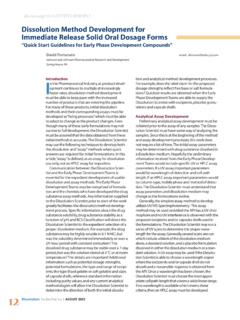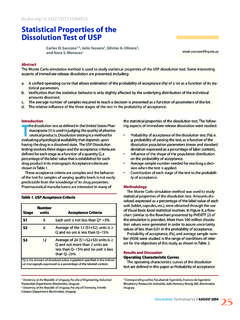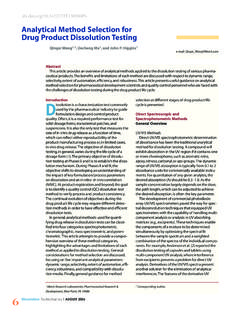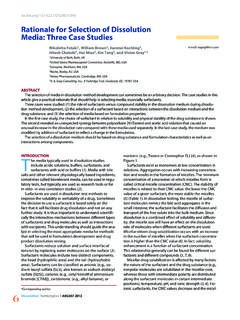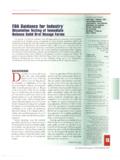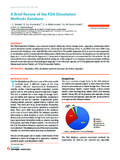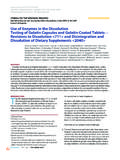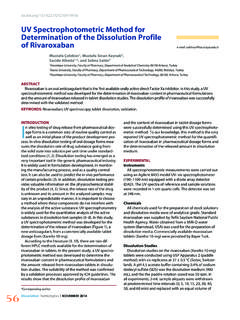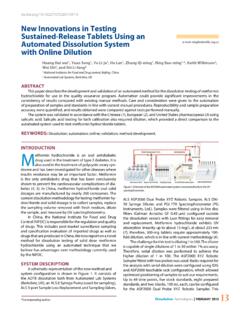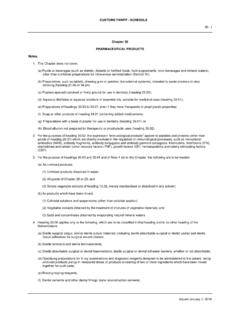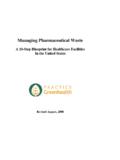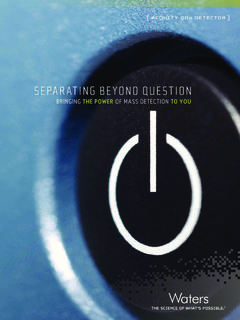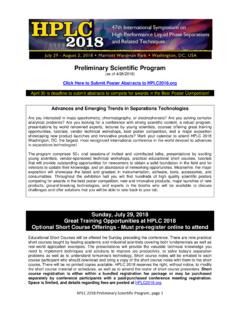Transcription of Dissolution Testing of a Controlled- Release Capsule ...
1 6 Dissolution Technologies | MAY 2013 Dissolution Testing of a Controlled- Release Capsule formulation : challenges and solutions Using a Semi-Automated Dissolution SystemLili Lo, Xujin Lu*, and David LloydAnalytical and Bioanalytical Development, Bristol-Myers Squibb, New Brunswick, NJ 08903 ABSTRACTA Controlled- Release formulation was developed using enteric-coated beads in a hard gelatin Capsule shell. This formulation requires two-stage Dissolution Testing at low and neutral pH. Because of high toxicity and limited stability of the active phar-maceutical ingredient in aqueous solution at room temperature, it is preferable to limit the analyst s contact with the sample solutions during Testing , and aliquots from the Dissolution vessel need to be quickly filtered and refrigerated immediately after sampling.
2 To meet these challenges , a semi-automated Dissolution method was developed and validated. Dissolution samples are withdrawn and filtered into vials in the HPLC sample compartment where the temperature is controlled at 4 C. A fast HPLC method was developed with a 3-min run per injection, enabling analysis of the samples within a very short time after collection, thereby decreasing the sample storage time and potential for degradation. An evaluation was also conducted for comparison of serial and parallel operation of two Dissolution baths for the two-stage Testing . Serial operation was chosen for this method and applied with a medium-exchange technique, which is safe, robust, easy to perform, compliant with USP, and gives enhanced coating is a widely used technique for Controlled- Release oral formulation of pharmaceuti-cal products, specifically for delayed Release (1).
3 The formulation purposely limits drug Release in the stomach, but facilitates Release in the neutral environment of the intestine. It enables protection of the drug from the acidic gastric fluid to prevent possible degradation, as well as protection of the stomach from the drug to avoid pos-sible irritation and adverse effects. The enteric materials are usually applied to substrates like tablets, pellets, or beads. The coated pellets and beads are further filled into a Capsule shell (2 5).During development of an oncology drug at Bristol-Myers Squibb, the technology of coating on beads was applied to make a Controlled- Release Capsule formulation . The physiochemical properties of this drug posed signifi-cant challenges for the formulation development, espe-cially its instability in various conditions including (1) in an aqueous acidic environment,( 2) during the process of granulation, and (3) when in contact with enteric coating materials.
4 To overcome these challenges , the enteric-coat-ed beads were developed with multiple different coating layers. This formulation uses sugar spheres as the core substrate. The first coating layer on the sphere is a mixture of the drug and excipient. The second layer coating is an Opadry film that prevents drug from contacting the next layer, the final enteric coating. After the final enteric coating is applied, the beads are filled into a hard gelatin Capsule shell (Figure 1). The various dosage strengths of the capsules are made using different fill of enteric-coated beads has been performed in both gastric and intestinal media (5, 6). A two-stage Dissolution test is specified in USP General Chapter <711> Dissolution (7), in which the integrity of the enteric coat-ing is determined in an acidic environment and the drug Release is measured in a neutral environment.
5 The test can be performed using either medium-addition or medium-exchange methods; both start with an acid stage in N hydrochloric acid for two hours and follow with a buffer stage in phosphate buffer at pH for 45 min or a specific time as needed for the individual drug product. The qual-ity of the dosage form is ensured by meeting USP accep-*Corresponding : 1. Enteric-coated beads for Controlled- Release Technologies | MAY 20137tance criteria for the acid stage when the amount released is limited to 10% or less of the labeled content, as well as for the buffer stage when each unit releases not less than Q + 5% as determined for the design of the dosage addition or medium exchange both require unconventional operational procedures that are not required in the Dissolution test for immediate- Release and extended- Release dosage forms.
6 For the medium-ad-dition approach, a designated amount of concentrated phosphate buffer needs to be added to the Dissolution vessel to neutralize the medium to the target pH before the buffer stage starts. The operations of adding the buf-fer and adjusting the pH need to be completed within 5 min. For the medium-exchange approach, the acid medium is drained after two hours, and a full amount of pH buffer is added to the same vessel for the buffer stage. The dosage unit should be undisturbed during the medium change. Alternatively, the vessel containing the acid could be removed and replaced with another vessel containing the buffer, and the dosage unit transferred to the new performing the two-stage Dissolution test is labor intensive and requires well-trained analysts with a good level of experience.
7 For instance, 5 min is a very tight time period in which to complete the medium addition, pH adjustment, and pH confirmation for six vessels. Also, both medium-addition and medium-exchange approaches require the buffer medium to be preheated and equili-brated to 37 C. Zhao and co-workers (8) described a manually operated two-stage Dissolution method using medium addition and USP Apparatus 2 (paddle), in which the surfactant Tween 80 was also included in the media to enhance solubility of the drug in the buffer stage. However, for Testing of the oncology drug in our study, two additional challenges were encountered with manual operation. (1) It is preferable to limit the analyst s contact with the sample solutions during sampling and final washing because of the high cytotoxicity of this drug compound.
8 (2) The Dissolution aliquots need to be quickly filtered and refrigerated imme-diately after sampling due to limited stability of the API in aqueous solution at room or semi-automated Dissolution systems have been widely available and used in the industry for improvement of productivity with regulatory agency ac-ceptance and 21 CFR Part 11 compliance. Unfortunately, they are not specifically designed for automation of the two-stage Dissolution of delayed- Release formulations and may face challenges for special types of samples and Testing requirements. Fully automated systems all have the capability to perform multiple tasks without analyst attendance, including medium preparation and delivery to vessel, automated dosage-form introduction, automat-ed sampling, filtering, sample collection, vessel washing, and a variety of analytical finish options, such as online photometric analysis and on- or offline HPLC (9 11).
9 How-ever, some of them simply cannot be used for two-stage Dissolution because they only can prepare (preheating and degassing), hold, and deliver a single type of medium. Other systems may be capable of automatic medium ad-dition and replacement, but they may have a limitation when collecting samples if the sample storage rack cannot be temperature controlled . Therefore, these fully auto-mated systems were not suitable choices for Dissolution Testing of the Controlled- Release Capsule formulation in this study because of the refrigeration requirement for the sample semi-automated Dissolution system is usually a combi-nation of a Dissolution bath, an autosampler, and a fraction collector. It has most of the capabilities that the fully auto-mated systems have, except for medium preparation and vessel washing after Testing .
10 Many autosamplers are on the market and can be used in combination with devices made by the same or different vendors. Integrated semi-automat-ed Dissolution systems are also commercially available with online or offline detection. However, none of the semi-automated systems can perform the complete medium exchange, and none of the systems have a temperature- controlled sample storage rack on their fraction collection station to reduce drug two-stage Dissolution method was developed in this lab using the Waters Alliance Dissolution System (Alliance D) and semi-automation for the Testing of Controlled- Release enteric-coated beads in the Capsule formulation . This method uses USP Apparatus 1 (bas-ket) and the medium-exchange approach.
